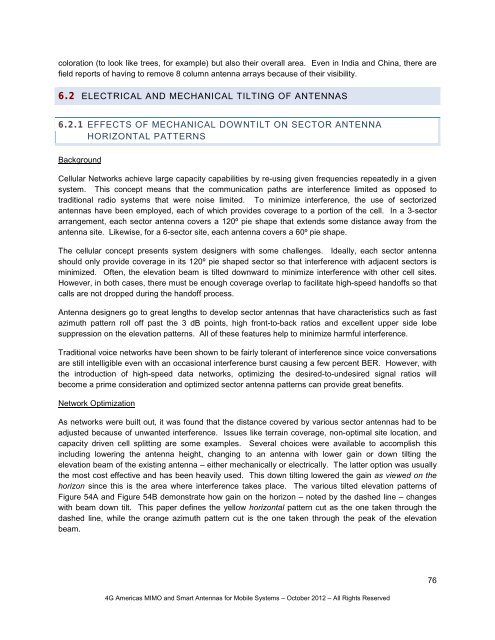MIMO and Smart Antennas for Mobile Broadband ... - 4G Americas
MIMO and Smart Antennas for Mobile Broadband ... - 4G Americas
MIMO and Smart Antennas for Mobile Broadband ... - 4G Americas
You also want an ePaper? Increase the reach of your titles
YUMPU automatically turns print PDFs into web optimized ePapers that Google loves.
coloration (to look like trees, <strong>for</strong> example) but also their overall area. Even in India <strong>and</strong> China, there arefield reports of having to remove 8 column antenna arrays because of their visibility.6.2 ELECTRICAL AND MECHANICAL TILTING OF ANTENNAS6.2.1 EFFECTS OF MECHANICAL DOWNTILT ON SECTOR ANTENNAHORIZONTAL PATTERNSBackgroundCellular Networks achieve large capacity capabilities by re-using given frequencies repeatedly in a givensystem. This concept means that the communication paths are interference limited as opposed totraditional radio systems that were noise limited. To minimize interference, the use of sectorizedantennas have been employed, each of which provides coverage to a portion of the cell. In a 3-sectorarrangement, each sector antenna covers a 120º pie shape that extends some distance away from theantenna site. Likewise, <strong>for</strong> a 6-sector site, each antenna covers a 60º pie shape.The cellular concept presents system designers with some challenges. Ideally, each sector antennashould only provide coverage in its 120º pie shaped sector so that interference with adjacent sectors isminimized. Often, the elevation beam is tilted downward to minimize interference with other cell sites.However, in both cases, there must be enough coverage overlap to facilitate high-speed h<strong>and</strong>offs so thatcalls are not dropped during the h<strong>and</strong>off process.Antenna designers go to great lengths to develop sector antennas that have characteristics such as fastazimuth pattern roll off past the 3 dB points, high front-to-back ratios <strong>and</strong> excellent upper side lobesuppression on the elevation patterns. All of these features help to minimize harmful interference.Traditional voice networks have been shown to be fairly tolerant of interference since voice conversationsare still intelligible even with an occasional interference burst causing a few percent BER. However, withthe introduction of high-speed data networks, optimizing the desired-to-undesired signal ratios willbecome a prime consideration <strong>and</strong> optimized sector antenna patterns can provide great benefits.Network OptimizationAs networks were built out, it was found that the distance covered by various sector antennas had to beadjusted because of unwanted interference. Issues like terrain coverage, non-optimal site location, <strong>and</strong>capacity driven cell splitting are some examples. Several choices were available to accomplish thisincluding lowering the antenna height, changing to an antenna with lower gain or down tilting theelevation beam of the existing antenna – either mechanically or electrically. The latter option was usuallythe most cost effective <strong>and</strong> has been heavily used. This down tilting lowered the gain as viewed on thehorizon since this is the area where interference takes place. The various tilted elevation patterns ofFigure 54A <strong>and</strong> Figure 54B demonstrate how gain on the horizon – noted by the dashed line – changeswith beam down tilt. This paper defines the yellow horizontal pattern cut as the one taken through thedashed line, while the orange azimuth pattern cut is the one taken through the peak of the elevationbeam.<strong>4G</strong> <strong>Americas</strong> <strong>MIMO</strong> <strong>and</strong> <strong>Smart</strong> <strong>Antennas</strong> <strong>for</strong> <strong>Mobile</strong> Systems – October 2012 – All Rights Reserved76
















